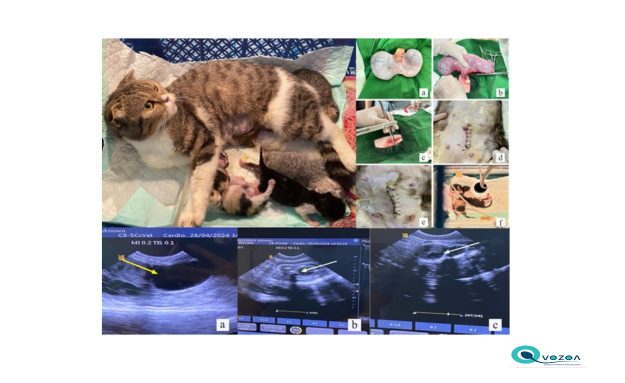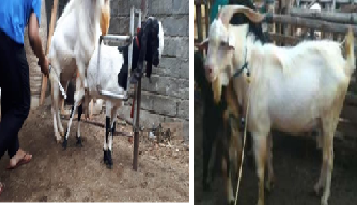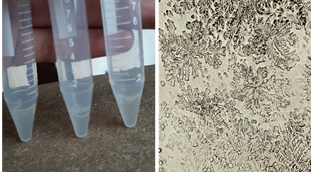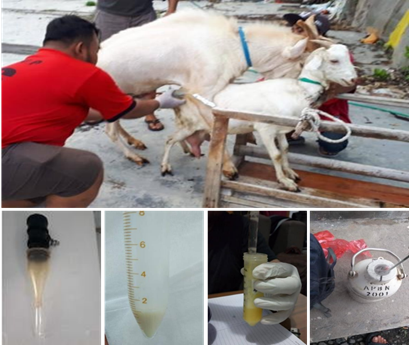Dystocia management in a Scottish Fold cat with caesarean section and ovariohysterectomy at Winadivet clinic Malang

Downloads
The causes of dystocia can be categorized into maternal and fetal factors. Dystocia is most commonly observed in queens that are giving birth for the first time. This study aims to assess the diagnosis and management of maternal dystocia in Scottish Fold cats through caesarean section (C-section). A general examination, including palpation, revealed the presence of a fetus, followed by an ultrasound to determine the number of fetuses and their viability. A hematological examination was conducted prior to the surgical procedure to assess the presence of anemia in the patient. A C-section was performed on the ventral aspect of the abdomen, followed by ovariohysterectomy after the successful removal of two live fetuses. Postoperative care involved the administration of the antibiotic Colibact, the anti-inflammatory meloxicam, supportive therapy including Channa Lakta (lactation stimulant), Channafit (immunomodulator), and the multivitamin Pantex. The results indicated that the wound of the patient, Koko cat, had closed by the third postoperative day. It can be concluded that appropriate treatment and management contribute to a rapid recovery process.
Amrozi, Soehartono RH, Adisya ER, Mahardi I, Mukarromah H, Satria MI, Achmadi B, Kamiring, A, Latif AA. 2020. Operasi caesar kasus distokia pada kuda miniature. ARSHI Vet Lett. 4: 45-6.
Aprily NU, Sambodho P, Harjanti DW. 2016. Calving evaluation of dairy cattle in Balai Besar Pembibitan Ternak Unggul dan Hijauan Pakan Ternak, Baturraden. J Pet Indones. 18: 36-43.
Aprilianti Y, Ragmiati DU, Setyoeati EY, Dahlan A. 2020. Potency of ketamine hydrochloride, atropine sulphate, and xylazine hydrochloride combination as in anesthetic agent on domestic male cats. Indones Medicus Veterinus 9: 475-8.
Apritya D, Ardiani T. 2015. Perbandingan mula dan lama kerja anestesi umum dengan premedikasi antara acepromazine dengan kombinasi acepromazine-atropine sulfat pada kucing lokal (Felis domestica). J Vitek Bidang Kedokteran Hewan 5: 1-6.
Audina NT, Yusmawan W, Naftali Z, Suprihati. 2019. Perbandingan kejadian leukopenia dan trombositopenia pada penderita karsinoma nasofaring yang mendapatkan kemoterapi Paclitaxel Cisplatin dan Cisplaton 5-Fluirouracil (5-FU). J Kedokteran Diponegoro 8: 1187-96.
Bailin HG, Thomas L, Levy A. 2022. Retrospective evaluation of feline dystocia: clinicopathologic findings and neonatal outcomes in 35 cases (2009–2020). J Feline Med Surg. 24: 344-50.
Distira LAY, Wirata IW, Wandia IN. 2024. Enucleasi of bulbus oculi prolapsus in terrier mix. J Ilmu Kesehatan Hewan 8: 72-80.
Greco DS, Davidson AP. 2017. Blackwell's Five-Minute Veterinary Consult Clinical Companion: Small Animal Endocrinology and Reproduction. John Wiley & Sons.
Haben F, Guesh N. 2020. Dystocia due to secondary uterine inertia in dog and its surgical management. Int J Clin Stud Med Case Rep. 4: 1-3.
Hermawan IP, Darantika G, Lonai NB. 2022. Studi kasus: Canine parvo virus pada anjing Boston di Lingkar Satwa Animal Care. J Vitek Bidang Kedokteran Hewan 12: 1-7.
Holst BS, Axnér E, Öhlund M, Möller L, Egenvall A. 2017. Dystocia in the cat evaluated using an insurance database. J Feline Med Surg. 19: 42-7.
Naoman UT. 2021. Causes and treatment of feline dystocia. J Appl Vet Sci. 6: 28-31.
Naomi C, Gorda IW, Warditha AAGJ. 2019. Case report: cutaneous haemangioma in local Balinese dog. Indones Medicus Veterinus 8: 131-43.
Niga MIB, Suptijah P, Trilaksani W. 2022. Isolasi dan karakterisasi ekstrak tepung ikan gabus dam potensinya sebagai imunomodulator. Jurnal Pengolahan Hasil Perikanan Indones. 25: 52-66.
Niyas E, Vidya VK, Athira, KS, Anjaly S, Amritha A, Abhilash RS, Reshma S. 2023. Surgical intervention for management of dystocia in a Persian cat due to partial primary uterine inertia. Pharm Innov J. Vol. 12: 658-60.
Nopitasari BL. 2022. Studi penggunaan obat pada pasien osteoarthritis usia lanjut di Instalasi Rawat Jalan Rumah Sakit Umum Daerah Provinsi NTB periode 2019. LUMBUNG FARMASI: Jurnal Ilmu Kefarmasian 3: 246-53.
Moura LMS, Rodrigues NM, Rodrigues MC, Quessada AM. 2023. Reproductive emergencies in female cats. Campo Grande 28: 59-71.
Pratiwi KN, Yuwindry I, Manto OAD. 2020. Studi farmakovigilans efek samping multivitamin di masyarakat Palangka Raya. J Pharm Care Sci. 1: 28-35.
Prudenta O, Mardasella A, Sahmiranda D, Ardianto Y, Aeka A. 2021. Chronic kidney disease in domestic shorthair cat. Media Kedokteran Hewan 32: 29-39.
Rahmiati DU, Wira DW. 2019. Induksi anestesi menggunakan Ket-A-Xyl ® pada kucing domestik. ARSHI Veterinary Letters 3: 53-4.
Ramadhayani AN, Lusiana V. 2022. Klasifikasi jenis kucing menggunakkan algoritma principal component analysis dan K-nearest neighbor. J Informasi dan Komputer 201: 257-63.
Wardhani MK, Sudarwati, Aryati I, Mukarromah S. 2021. Keputusan pembelian ulang ditinjau dari citra merek, media iklan, dan brand trust pada produk Imboost di Surakarta. J Ilmiah Edunomuka 5: 224-34.
Copyright (c) 2025 Intan Firdha Olien Noor Al Ichsan, Drh. Viski Fitri Hendrawan, M. Vet., Gretania Residiwati, Galuh Chandra Agustina, Winda Syafitri

This work is licensed under a Creative Commons Attribution-ShareAlike 4.0 International License.
Ovozoa by Unair is licensed under a Creative Commons Attribution-ShareAlike 4.0 International License.
1. The journal allows the author to hold the copyright of the article without restrictions.
2. The journal allows the author(s) to retain publishing rights without restrictions
3. The legal formal aspect of journal publication accessibility refers to Creative Commons Attribution Share-Alike (CC BY-SA).
4. The Creative Commons Attribution Share-Alike (CC BY-SA) license allows re-distribution and re-use of a licensed work on the conditions that the creator is appropriately credited and that any derivative work is made available under "the same, similar or a compatible license”. Other than the conditions mentioned above, the editorial board is not responsible for copyright violation.




































